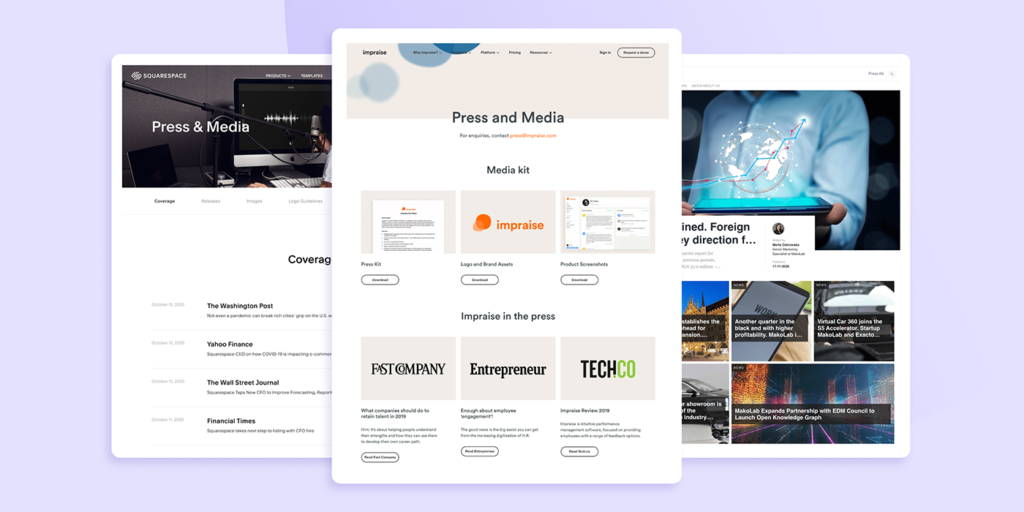Newswires are one of the oldest relics of the old world of public relations. They were once the most effective way to get a story noticed by media professionals.
But do they have any merit in 2024? How much do they cost and is there a better alternative?
- What is a PR newswire?
- Newswires evolution
- PR newswire vs. media outreach vs. online newsroom
- Pros and cons of using newswires
- How much does PR newswire cost?
- What is more effective: a targeted media outreach or a newswire?
- Should you still use a PR newswire in 2025
These are just some of the many questions we'll answer today.
What is a PR newswire?
PR newswire is an organization that collects and distributes news and information to media outlets, journalists, newspapers, radio stations, and anyone who might want a new story to cover.
In the days of old, journalists had to search for sources for their stories.
A newswire service delivered the most important press releases directly to them so that they could pick the stories they wanted to cover. In the modern age, journalists can browse the web and find their next story in minutes, making newswires a bit obsolete - but more on that later.
Types of newswires
There are several main types of newswires:
▪️ News agencies (such as Reuters or AP): traditional agencies with original content
▪️ PR distribution services (e.g. PR Newswire, Business Wire): services that distribute press releases on behalf of organizations and companies
▪️ Financial newswires (e.g. Bloomberg, Dow Jones): newswires focusing exclusively on financial news and updates
▪️ Industry-Specific Newswires (e.g. Techcrunch, Medical News Today): which focus on specific industries
▪️ Regional or Local Newswires (e.g. APAC Newswire, Latin American News Agency aka LANA): cover topics related to specific areas
And besides that there are also media databases and tools that help pitch journalists personally and foster better media relations, such as Prowly.
Newswires evolution
From traditional media to the age of the internet, newswires have gone through many changes. Here are some of the milestones that changed the PR game:
- 1846: Associated Press is founded; they used the Pony Trail to deliver news during the Mexican War
- 1860s: The transatlantic cable is used to communicate globally
- Late 1800s - early 1900s: Press release distribution services move to phones and away from telegraphs
- Late 20th century:
- Shift to digital technologies, replacing analog communication
- Newswires add multimedia elements
- 21st century:
- The internet creates a revolution in news distribution, making newswires digital
- The globalization of newswires - they reach worldwide audiences and cross borders
PR newswires in the PESO model
After Gini Dietrich came up with the PESO model, which categorizes media into four types: paid, earned, shared and owned, all PR pros and marketers included it into their strategies.
Naturally, newswires also fit into that framework, more specifically: into the earned media category.
As a part of the PESO model, newswires help businesses get coverage through PR efforts. This includes news articles, media features, interviews and other media formats a business can get through media relations.
PR newswire vs. media outreach vs. online newsroom
If you want to get eyeballs on your press release, you might consider these three choices.
👉 PR newswires help get earned coverage that is not paid for (directly). However, it’s not free of charge either.
Newswire services cost considerable money and their effectiveness can be questionable, which makes this choice not an easy one to make.
👉 PR outreach means building personal relationships with journalists, bloggers, influencers and other content creators through PR.
It's a great long-term strategy because you don't just publish stories - you build relationships.
👉 Online newsrooms are places where a brand controls and publishes content such as press releases, company materials and information.
As this falls under the Owned category in the PESO model, these channels are secure and give you more freedom in choosing what to publish.

All three methods have their pros and cons and, ideally, you want to use a combination of them all to maximize the reach and impact of your press releases.
Pros and cons of using a newswire
Using a newswire service in 2024 has its upsides and downsides. And while many journalists don't use newswires anymore, that doesn't mean they don't have a place in modern journalism and reporting.
What are the possible pros of newswires?
➕ Newswires ensure broad reach and visibility: as there are still many journalists using these services to get targeted stories.
➕ Efficient media outreach: your business newswire is going to the addresses of real journalists and you don't waste time knocking on the wrong doors.
➕ Industry relevance: your news stories show up at the addresses of media specialists covering your specific industry.
➕ Reputable newswires have editorial processes in place: which make sure all news is fact checked, which gives you an additional layer of safety.
➕ Supports integrated media strategies: a press release wire lets you cover a lot of ground at once by providing a centralized way for media outlets to access information about a business or event.
Newswire downsides:
➖ High volume and competition: with so many PR newswires being released daily, you're fighting for journalists' attention in a tough, competitive crowd, and if journalists don’t know you personally, they might be less eager to cover your story.
➖ No one can guarantee you coverage: just because you pay a few hundred dollars for a PR newswire press release, it does not mean that journalists will pick it up - you need to use other methods besides newswires for a bigger reach.
➖ High costs: not only do you not have guaranteed reach, but you also pay steep prices for newswires, going into the hundreds of dollars - without certain ROI.
➖ Risk of overlooking genuine news: when sources post press releases on newswires, the platforms get flooded, and journalists can miss actual news.
➖ Strategic considerations: if you want to send exclusive pitches and embargoed releases, this won't go well with the nature of newswires. You should only use newswires when they align with your overall campaign goals.
When shouldn’t you use a newswire?
While there are circumstances that might call for using a newswire, there are also specific cases when using it can hurt your PR efforts, such as:
1️⃣ When you have an exclusive story
Instead of pitching to a hand-picked number of journalists, a newswire spreads your story to everyone who is subscribed to it. Also, if you're giving one journalist an exclusive story, publishing it on a newswire will spoil trust.
2️⃣ When you have niche or localized news
In these cases, a global newswire will be a poor move as a global audience won't be interested in niche bits of news.
3️⃣ When newswires are proven to be ineffective for your industry
For example, in healthcare and similarly regulated industries which don't fare well with newswires.
4️⃣ When you have limited resources
As you've seen above, using a newswire can get very expensive. If you don't have an endless PR budget, consider more cost-effective methods, such as personalized outreach with tools like Prowly.
5️⃣ When you want to focus on building relationships with journalists
Media outreach tools let you nurture relationships with individuals rather than blasting your messages into the void.
How much does it cost to distribute a press release with a PR newswire?
A press release distribution service does not come cheap. Here are some of the most popular choices and how much they will set you back.
Newswire examples and costs
First of all, to get to know all about the best newswire websites, their features and pricing, make sure to read this piece on the Best Press Release Websites, it’s a great starting point.
TL;DR here are some of the most popular newswires and how much they cost:
- Presswire: from $250 /release
- Newswire: from $349.00 /release
- 24-7 Press Release Newswire: from $29 /release
- PR.com: from $60 /release
- eReleases: from $399 /release
- PRfree: offers both free and paid options (from $19 /release)
- PRLog: offers both free and paid options (from $29 /release)
- PRLeap: offers both free and paid options (from $135 /release)
However, it gets more tricky when you try to compare the price of a specific service, such as a PR newswire, and the cost of media outreach through different channels.
PRNewswire pricing vs. media outreach cost
Primarily, this is because you need to add the extra costs on top of the costs for the paid plans for your releases.
Also, pricing isn’t often transparent and precise information is hard to find.
👉🏼 You can’t just count the price per press release.
You have to pay annual membership fees and then a specific amount of money for each press release that goes out. And you need to keep word count in mind, because you need to pay extra if you exceed set limits.
Want to include media such as images or videos? That will be another extra cost per press release. And to include a logo, the annual price goes up again.
For more details, take a look at the infographic below and this article on an Effective PR Newswire Alternative & Price Comparison.
The bottom line? PRNewswire pricing isn't easy to eastimate. And it’s not tailored to specific journalists like personal pitching. But if it aligns with your goals, you can consider testing it out in your strategy.
Newswire alternatives
On the other hand, you have tools that let you pitch journalists and media such as Prowly.
For $369 per month, you get access to Prowly’s media contact database (with 1,000,000+ journalists), can send 1,000 emails, and create press releases with unlimited words which include your logo + photos, videos and social media posts at no extra cost.
👉🏼 This gives you a clearer expense and ROI estimation for your PR campaigns and a chance to make a real impact with each press release.
So after creating your press release (with the help of AI), you can easily distribute it to journalists with laser precision.
This brings us to our next question.
What is more effective: a targeted media outreach or a newswire?
Long story short: traditional newswires distribute your press release to a wide audience, hoping that it sticks somewhere. Today's PR industry is shifting to a different approach: targeting a smaller, more relevant group of journalists and content creators to get better results with each campaign.
With a targeted media outreach platform on the other hand, you don't blindly blast press releases into the void. You target journalists and outlets that might be genuinely interested in your story.
You can then send personalized media pitches based on previous interactions with them.
Here are some other things you can do after investing in a PR tool instead of a newswire:
#1 Creating press release drafts and pitches with AI
If you don't know how to get started with your next press release, AI press release creators help overcome writers’ block so you can go from a blank document to a finished press release in minutes.

Just give it some input: answer the questions, add your details, and you can see the press release come to life in front of your eyes in real time.
The only things left are: polishing it and pitching the right media.
And you can also draft of your pitch with AI based on your press release - just like in the photo above.
#2 Pitching journalists more efficiently
With Prowly, you get recommended contacts for your press release so you can send targeted pitches that get results. You also get tips on how to avoid spam filters in email inboxes and ensure your messages get seen. Plus you can personalize your emails and schedule follow ups. All in one place.
#3 Posting to your online newsroom
Besides relying on getting coverage from the media, you can upload press releases straight to your Online Newsroom as well, and make use of a channel you own with just a few clicks.
This is a tool you get in the price of your Prowly subscription, so you can treat it as a place for extra exposure where you set the rules. While it's easy for false narratives about your brand to form in the online world, your newsroom can be a reliable source of your or your client’s news for journalists.
Should you still use a PR newswire in 2025?
There is no definitive answer, but our latest research in PR trends for 2024 shows that PR specialists now prioritize long-lasting, strong relationships with journalists. Also 37% of respondents said investing more into strategic partnerships will be key.
And the fact that 14.2% recommend abandoning mass media emails entirely underscores the importance of personalization in today's world and shows what traditional methods are falling out of favor.
That doesn't mean you should drop using PR pitching tools now. Most of them, including Prowly, allow personalization even if you're pitching a few journalists at once - and you can schedule follow up emails in advance if they don't reply to the first pitch!
Using newswires is the exact opposite of these trends, as you're shooting news out to the masses, hoping for someone to grab onto your story.
The modern PR pro puts importance on creating data-driven strategies and fostering relationships through personalization. They want to join communities and create narratives instead of having one-off encounters with journalists.
And getting the attention of journalists is a rising challenge. Having amazing subject lines no longer cuts it. You need to know the right people, send the right message at the right time, and sometimes wait for months to see the fruits of your labor.
Choose your method
We can’t tell you whether you should or shouldn’t use a newswire. For some goals they might work, for others they aren’t a good way to go.
However take into the consideration the points mentioned in this article when choosing your distribution strategy, such as:
- Costs vs. features you get & probable outcomes
- Mass distribution vs. personal pitching
And if you want to get advanced features along with a media database and a pitching tool, invest your money in software that lets you do targeted media outreach, such as Prowly.


